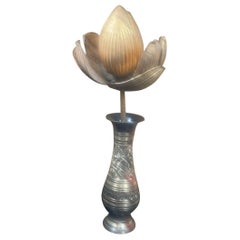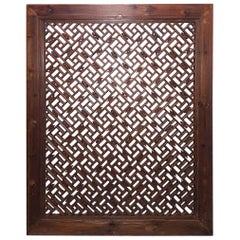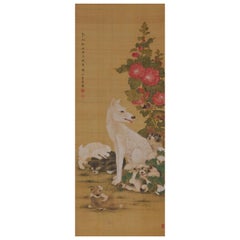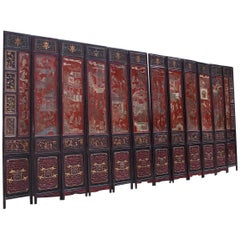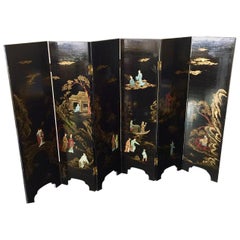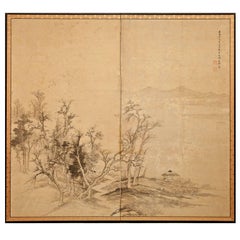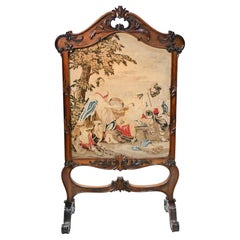1840s Paintings and Screens
4
to
1
3
4
4
4
161
588
915
164
313
221
119
38
4
29
18
14
24
22
21
24
9
3
1
1
1
1
4
4
2
2
Period: 1840s
Japanese Fine Antique Gilt Lotus Bud Flower, Edo Period 19th Century
Located in South Burlington, VT
From our recent Japanese acquisitions, a rare find, stem #3
Antique Original Japanese temple "blossominig lotus" flower bud stem. This finely hand carved wood and lacquered gold flower stem was made for a Buddhist 19th century temple altar...
Category
Japanese Edo Antique 1840s Paintings and Screens
Materials
Wood
Mid-19th Century Peachwood Window Screen from Sianxi, China
Located in New York, NY
An antique window screen from Sianxi, China, Mid-19th Century.
Solid peachwood in dark finish with intricate floral hand-carvings in diagonal p...
Category
Chinese Qing Antique 1840s Paintings and Screens
Materials
Wood
1844 - Chichi, Japanese Scroll Painting. Colour on Silk
Located in Kyoto, JP
Mother’s Breast (Chichi) 1844
Hanging scroll. Ink, pigments and gofun on silk.
Inscription:
Kouka era, dragon year, late winter, painted by Shozan Yashou
Artist’ seals:
...
Category
Japanese Edo Antique 1840s Paintings and Screens
Materials
Silk
Chinese Coromandel Red Lacquer 12-Panel Figural and Landscape Screen. Circa 1840
Located in Hollywood, SC
Chinese Coromandel figural red lacquer 12-panel screen depicting pagoda and landscape scenes, decorative gilt floral border panels, gilt carved lower panels, and reverse side depicti...
Category
Chinese Chinese Export Antique 1840s Paintings and Screens
Materials
Wood, Giltwood, Lacquer, Paint
Related Items
Chinese Six-Panel Lacquer Screen
Located in Montreal, Quebec
Chinese six-panel lacquer screen.
This lovely and versatile screen is in the great style of Coco Chanel who loved to decorate with Coromandel s...
Category
Chinese Chinoiserie 1840s Paintings and Screens
Materials
Wood
Japanese Two-Panel Screen: Ink Landscape on Silk
By Shunyu
Located in Hudson, NY
Japanese Two Panel Screen: Ink Landscape on Silk, Meiji period (1868 - 1912) painting of a man riding a mule on a pathway through the Kurotani mountains with a thatched roof shelter ...
Category
Japanese Meiji Antique 1840s Paintings and Screens
Materials
Silk, Wood
Chinese Export Gilt Coromandel Screen Manchurian Cranes
Located in Rio Vista, CA
Fantastic Chinese export four-panel lacquered coromandel screen featuring an idyllic pond landscape with eight red crowned cranes or Manchurian cranes...
Category
Chinese Chinese Export 1840s Paintings and Screens
Materials
Gold Leaf, Brass
Chinese Six-Panel Rosewood Carved Lattice Screen
Located in Rio Vista, CA
Fantastic Chinese six-panel Rosewood carved lattice folding screen. Features intricate geometric patterns with Greek key motif. Each panel is 17.5 inches wide and has a contrasting o...
Category
Chinese Ming 1840s Paintings and Screens
Materials
Brass
Chinese Qing Four Panel Lacquered Incised Coromandel Screen
Located in Rio Vista, CA
Rare unusual late 19th century/early 20th-century Chinese Qing four-panel coromandel screen. The front features dark red lacquer decorated with scholars objects and small landscape s...
Category
Chinese Qing Antique 1840s Paintings and Screens
Materials
Brass
Chinese Export Four Panel Coromandel Screen Pearlescent Landscape
Located in Rio Vista, CA
Captivating Chinese export four-panel coromandel screen featuring an idyllic seascape with beauties. The background is comprised of pearlescent crystal sand that shines like glitter ...
Category
Chinese Chinese Export 1840s Paintings and Screens
Materials
Brass
Mid-Century Chinese Export Four Panel Gilt Lacquered Coromandel Screen
Located in Rio Vista, CA
Heavenly Mid-Century Modern period Chinese export lacquered coromandel screen featuring four panels depicting celestial beauties in the sky with decorative ruyi clouds and moon. Soli...
Category
Chinese Chinese Export 1840s Paintings and Screens
Materials
Brass
Chinese Qing Four Panel Carved Soapstone Coromandel Screen
Located in Rio Vista, CA
Impressive Chinese late Qing dynasty four panel folding coromandel screen featuring carved soapstone. The lacquered panels are decorated with idyllic scenes of beauties in a pagoda p...
Category
Chinese Chinese Export 1840s Paintings and Screens
Materials
Soapstone, Brass
20th Century Chinese Gilt Coromandel Eight-Panel Screen Immortals Sky Gods
Located in Rio Vista, CA
Amazing Chinese export eight-panel lacquered coromandel screen depicting a heavenly scene of immortals and sky gods floating in ruyi clouds. The fascin...
Category
Chinese Chinese Export 1840s Paintings and Screens
Materials
Brass, Gold Leaf
H 96 in W 150 in D 0.75 in
Antique Signed Asian Watercolor on Silk Landscape Figure Scroll Cherry Blossom
Located in Dayton, OH
Signed antique Asian watercolor on silk landscape painting showing a small waterfall over a creek, topped with a tree and a woman carrying a b...
Category
Chinoiserie 1840s Paintings and Screens
Materials
Silk, Paint
H 74.75 in W 17.7 in D 1 in
Japanese Edo Period Six Panel Screen of Chinese Scholars
Located in Rio Vista, CA
Fascinating 19th century Japanese late Edo period six pane funpon screen. Large scale depicting Chinese scholars and officials engaged in leis...
Category
Japanese Edo Antique 1840s Paintings and Screens
Materials
Wood, Paper, Silk
Antique Double Sided Japanese Ranma Transom Panels - a Pair
Located in Morristown, NJ
19th/20th c., Antique hand-carved Japanese ramna panels depicting landscapes of black pine trees, temples, mountains and clouds. Likely carved from yaku cedar in the Osaka tradition of chokokuranma (carved transom), these are double sided three-dimensional landscape designs. The design is mirrored on each side of the panel.
Ranma panels...
Category
Japanese Meiji Antique 1840s Paintings and Screens
Materials
Wood, Cedar
Previously Available Items
Victorian Tapestry Screen Needlepoint Hand Woven 1840 Pastoral
Located in Potters Bar, GB
Wonderful Victorian tapestry screen showing a delightful English pastoral scene
We date this to circa 1840 and it comes in the mahogany frame which ...
Category
Victorian Antique 1840s Paintings and Screens
Materials
Mahogany
19th Century Japanese Landscape Rinpa School Folding Screen Six Panels Gold Left
Located in Brescia, IT
Landscape with flowering sakura trees of the Edo period.
Six-panel screen painted with mineral pigments and inks on gold leaf from the Rinpa School.
Category
Japanese Edo Antique 1840s Paintings and Screens
Materials
Gold Leaf
H 67.33 in W 149.61 in D 0.79 in
Two Panel Ink and Gold Leaf Japanese Screen
Located in Stamford, CT
Two panel ink and gold leaf Japanese screen depicting water, weeping willows and a blossoming bush. 19th century Edo period in the style of the earlier 17th century Edo period.
Category
Japanese Edo Antique 1840s Paintings and Screens
Materials
Paper
Kishi Ganryo “Flowers of the Four Seasons” Japanese Folding Screen
By Kishi Ganryo
Located in Kyoto, JP
Kishi Ganryo (1798-1852)
“Flowers of the Four Seasons”
Six-panel screen, ink, color and gold leaf on paper.
Inscription: Utanosuke Ganryo
Artist seals:
Ganryo no in
Shiryo
Dimensions:
170 cm x 556 cm (67” x 219”)
Flowers and plants have long held an important role as signifiers of meaning in Japanese culture. Hanakotoba is the Japanese ‘language of flowers’. Essentially, each flower has its own meaning, often based on its physical attributes and/or well known appearances in historical art and literature. This floral screen by Kishi Ganryo is rich with emotional sentiments. The flowers chosen epitomise femininity and the theme is unambiguously romantic. The work was likely commissioned as a dowry gift for a bride.
The screen is ‘read’ from right to left, from spring through to winter. Flowers associated with spring include wisteria, which represents the intoxication of love, bleeding hearts embody femininity and gentleness, and the stem peony timidity and purity. Moving through to summer the pink morning glories represent binding love; they are entwined around tiger lilies which embody prosperity. The white chrysanthemum, an eternal symbol of autumn, represents trust and purity. It is placed next to the cockscomb which stands for emotion and affection. Amongst the pampass grass is the bellflower, which represents unchanging love and honesty. In winter the Nandina flourishes and it is seen as a purifying plant. It is set among bamboo which is a symbol of perseverance and tolerance.
It is highly unusual in that the four seasons are represented on one screen as a complete work of art. Almost invariably spring and summer would be presented on one screen and fall and winter on the matching pair. The screen is also extraordinary in its grand size, measuring 18 feet across. There is a wonderful Japanese sense of composition, revealing just the centre part of the tree-trunk, and the tips of plants and grasses, which gives the impression that you are looking out of a window. In particular the twisting wisteria vines bring to mind Maruyama Okyo’s famous wisteria screens. Against the gold-leaf ground the flowers dazzle with realism. It is a very important and representative work by Ganryo, who was known as a careful observer of nature and talented colorist.
Kishi Ganryo’s given name was Hamatani Masatoshi. He studied painting under Kishi Ganku...
Category
Japanese Edo Antique 1840s Paintings and Screens
Materials
Gold Leaf
Recently Viewed
View AllMore Ways To Browse
Antique Japanese Painting On Silk
Antique Japanese Paintings On Silk
Japanese Panel Folding
Japanese Edo Screens
Chinese Screen Two
Edo Panel
Japanese Pictures
Hand Painted Antique Screen
Vintage Asian Painting
Japanese Meiji Screen
Chinese Panel Lacquered Screen
Antique Door Screen
Antique Screen Doors
Chinese 4 Panel
Carved Window Panels
4 Panel Chinese
Black Lacquer Asian Painting
Asian Lattice
